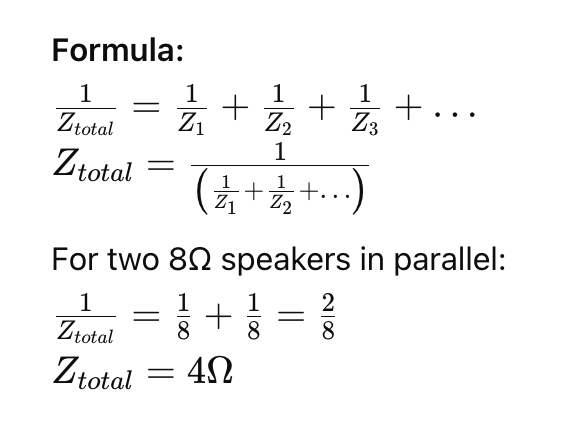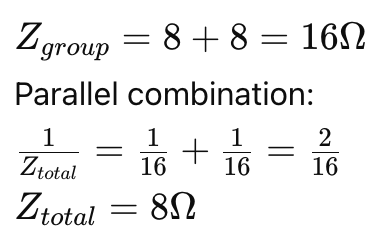I’ve done the hard work to help you calculate the impedance (ohms) of up to 6 speakers with just a click. You can use the calculator for quick calculation of impedance. To understand the formulas behind this and to calculate yourself in the future, refer to the guide provided below the calculator.
Speaker Ohm Calculator
When setting up an audio system, you need to understand the speaker impedance to avoid any damage to your equipment. In wiring speakers, there are four methods; series, parallel, series-parallel, and parallel series. In this guide, I have explained all four methods to compute the total impedance and also guided you in calculating it using formulas.
What is Speaker Impedance?
Speaker impedance is the resistance of speakers to the amplifier signals. It is measured in OHMs (Ω). Total speaker impedance depends on the wiring method used. Thus, by changing the wiring method, you can change the total impedance. You can test this in the calculator by checking the impedance for each wiring method one by one while other values are same. Or continue reading below to understand all the methods.
4 Common Speaker Wiring Methods
There are 4 most commonly used methods for wiring speakers. Let’s discuss them one by one.
1. Series Wiring
In series wiring, all the speakers are connected in a row i.e. “+” terminal of the first speaker is connected to the “-” terminal of the second speaker, and so on. In the end, total impedance is the sum of individual impedances of each speaker.

For example, three 8Ω speakers in series will output a total impedance of 8+8+8=24Ω.
2. Parallel Wiring
In parallel wiring, all “+” terminals are combined on one side while “-” terminals are combined on the other side. These are then connected to the amplifier. The impedance of this wiring type is measured by the reciprocal formula of series wiring.

3. Series-Parallel Wiring
Series-parallel wiring combines series and parallel connections. This wiring type offers more flexibility in controlling the output impedance.
Here are the steps to do it:
- Group speakers into parallel sets.
- Calculate the impedance of each parallel group.
- Combine the groups in series.
Example: For four 8Ω speakers (two parallel pairs joined in series):
Parallel group impedance:

4. Parallel-Series Wiring
Parallel-series is the inverse of series-parallel. It works by connecting series groups in parallel.
Here are the steps to do it:
- Group speakers into series sets.
- Calculate the impedance of each series group.
- Combine the groups in parallel.
Example: For four 8Ω speakers (two series pairs in parallel):
Series group impedance:

Why Proper Wiring Matters?
Incorrect impedance can damage your amplifier or reduce sound quality. Ensure the total impedance is within the range supported by your amplifier. Most amplifiers operate best at 4Ω to 8Ω loads.
Measuring Impedance with a Multimeter
If you are not sure about the impedance of any individual speaker, you can do so by using a multimeter. Here are the steps to do this:
- Disconnect the speaker.
- Set the multimeter to the Ohms setting.
- Measure across the speaker terminals. A 4Ω speaker typically measures 3.2–3.6Ω due to resistance variance.
Practical Tips
- Use a combination of wiring methods for large systems to maintain a safe impedance load.
- Avoid connecting odd numbers of speakers unless necessary, as power distribution may be uneven.
- For complex setups, consider speaker impedance adapters for safe operation.
Conclusion
I hope this comprehensive guide will not only help you calculate the impedance of speakers for easy setup but also help you understand how this actually works. Let me know in the comments section about your feedback. If you have any questions, you can ask in the community tab and many fellows will help you.
You can also use some other tools that will help you build an amazing audio setup at your home.